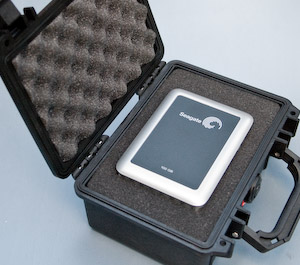2007-08-26

One of the best ways to back up 100GB or so of your most critical data is to a portable USB drive that you store offsite. They're easy to connect (no power supplies to deal with), small, and capacious (up to 160GB or more).
While the drive is offsite, the backed-up data on your computer is protected from almost all of the causes of data loss: hardware or software failure, electrical surge, human error, theft, and physical destruction (fire, explosion). If the offsite location is far enough away, you may also have protection from area-wide disasters (flood, earthquake, bombing).
If the offsite location isn't secure (e.g., a friend's house), it's a good idea to encrypt the backup. Not all backup programs can do that, but, at least on a Mac (don't know about Windows), you can format the drive as an encrypted disk image, and then back up to that.
If you have only one portable drive and you bring it back to your computer to refresh it, you lose most of its protective value while it's no longer offsite. So, you want two drives, one to keep offsite and one to keep nearby. Once every few days or so, depending on how much work you've done and what other backup methods you're also using (see note at end), you update the files on the nearby portable drive. Then you take it to the offsite location and exchange the two drives, bringing the old one back.
Fine, but do you just leave the drive loose in your briefcase or on the seat of your car while you're transporting it? And, where you you store it? In a desk drawer? (I once spilled coffee on a desk and it leaked into a drawer.) On a closet shelf?
A great solution is a Pelican 1120 foam-filled case (see photo above). It's waterproof, crush proof, corrosion proof, dust proof, and, because of the foam, light-impact proof. I got mine for $35 from REI (check their web site if you're not near a store). The 1120 has dimensions of 5 in. by 7.5 in. by 2.5 in. Allowing for some foam all around, it's perfect for small USB drives. If the 1120 isn't big enough, Pelican has many other sizes.
It turns out that the entire Pelican case fits into a small Sentry media safe (they go for about $200; don't get a cheap fire safe). So, while the non-offsite drive is near your computer, you can keep it in a media safe, and maybe it will even survive a fire. If it doesn't, that's OK, because the real backup is offsite.
Backup to a portable USB drive is only one element of an overall backup plan, although it's arguably the most important. You also want a disk image of your primary bootable disk, archival (maybe on DVD) backup of photographs and other stable files, working backup (e.g., flash drive) for frequent backups during the day of files you're working on, and maybe even online backup to supplement most of the above. I'll blog about some of these topics in the next few weeks.